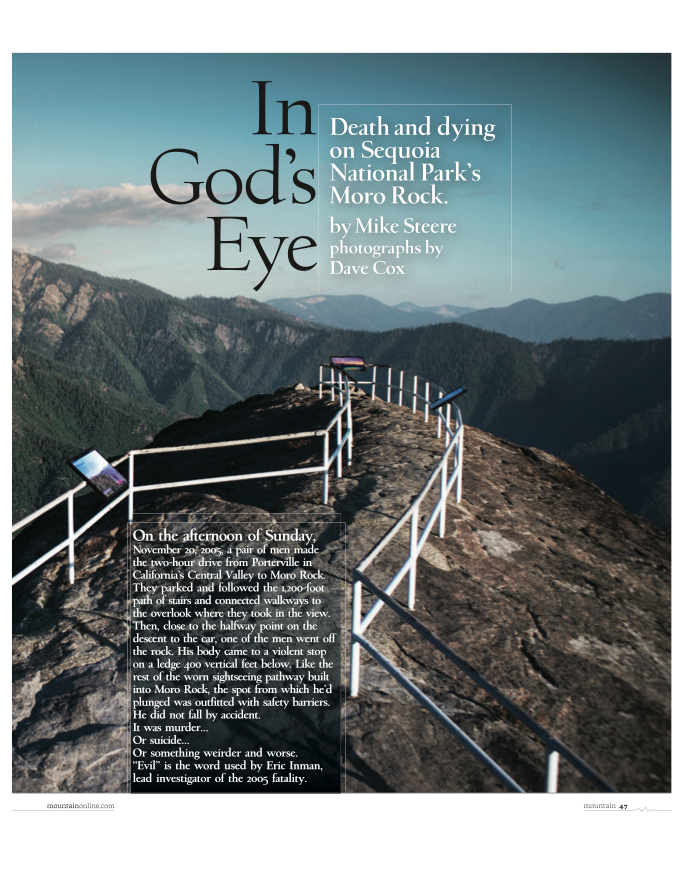Most of America’s national parks are wildernesses – uninhabited, unexplored, and ungoverned land blooming with criminal activity from drug production to human trafficking. This true crime drama is inspired by the true stories of Eric Inman, star Senior Criminal Investigator. Based on an article by Mike Steere that originally appeared in Mountain magazine. Eric Bana stars in the new six-episode series for Netflix from writers Mark L. Smith and his daughter, Elle Smith. The series is described as a character driven mystery thriller in which Bana plays Eric Inman, “a special agent for the National Parks Service who works to enforce human law in nature’s vast wilderness. The investigation of a brutal death sends Inman on a collision course with the dark secrets within the park, and in his own past.” Steve Lee Jones will serve as Executive Producer for the series.
Death and dying on Sequoia National Park’s Moro Rock.
By Mike Steere | Photographs by Dave Cox
On the afternoon of Sunday, November 20, 2005, a pair of men made the two-hour drive from Porterville in California’s Central Valley to Moro Rock. They parked and followed the 1,200-foot path of stairs and connected walkways to the overlook where they took in the view. Then, close to the halfway point on the descent to the car, one of the men went off the rock. His body came to a violent stop on a ledge 400 vertical feet below. Like the rest of the worn sightseeing pathway built into Moro Rock, the spot from which he’d plunged was outfitted with safety barriers. He did not fall by accident.
It was murder… Or suicide… Or something weirder and worse.
“Evil” is the word used by Eric Inman, lead investigator of the 2005 fatality.
Even while you stand on the high overlook on top of Moro Rock and rejoice in the view of Sequoia National Park and land to the west—some 13,500 feet of vertical relief from the snow-bright wall of the High Sierra down to near sea level in California’s Central Valley—you can get a little sad. You can’t stay up here forever or even for very long. There’s a need to keep moving so as not to miss other wonders, chief among them Sequoia’s namesake trees. The giants are the biggest in the world, alive centuries before Jesus. Over on Sequoia Park’s eastern boundary rises 14,500-foot Mount Whitney—the highest peak in the Lower 48.
Moro Rock is a less famous Sierra granite dome in the geologic family of El Capitan in Yosemite Park. Except here, the monolith shoulders its way out of Sequoia’s centerpiece Giant Forest. The Moro Rock pathway, built in 1931, is on the National Register of Historic Places. It was designed by a landscape architect to blend into the rock’s contours.
Moro Rock and the surrounding forest is just a scrap of the combined Sequoia and Kings Canyon National Parks. Ninety-seven percent of the land, which totals 865,964 acres, is designated wilderness, much of it high and seriously rough. Sequoia is also a roots national park. Established in 1890, it’s the second oldest in the park system. National Park Service rangers everywhere honor Sequoia Park. Look closely at the embossed leather belts and hatbands and you see little sequoia cones. For true believers in the sanctity of wild places and preservation for all time, it is big to be here.
Up on Moro Rock I glory in the view. Returning to the car, down oddly urban flights of concrete steps with steel railings polished by countless hands, I keep stopping on the narrow walkways to capture scenics with my phone. Close to the final sets of steps I meet a guy with a camera.
“Take all the pictures you can,” he laughs, “and you still won’t be able to tell the story.”
He means the story of being here right now. We can’t cheat time; can’t keep the mortal moment alive, but we try anyway. This is the man with a camera’s cosmic joke.
But it’s the other Moro Rock story—murder, suicide, evil—that brought me to Sequoia Park.
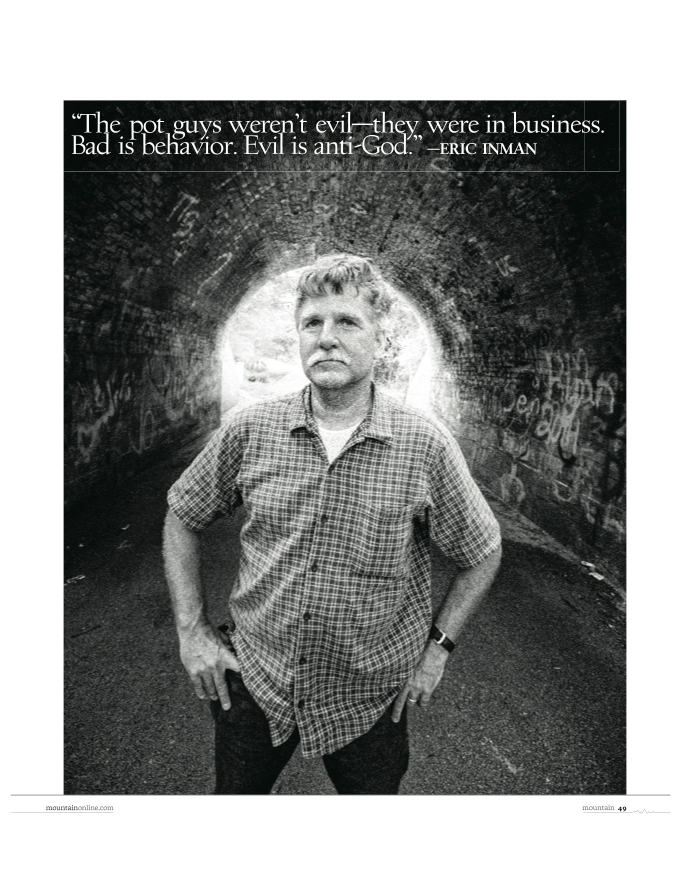
The first time I heard Inman speak the word “evil” in regards to Moro Rock was in 2006. “I’ve never come across anything like it,” he said.
Inman spoke in his quiet, careful, flat-affect way, but that only heightened the drama. The story was unique in his long experience as a lawman. Malevolent. At the time, Inman was a Senior Special Agent for the National Park Service—a criminal investigator. Based in Sequoia, he was a year short of retirement after 21 years in the Park Service spent mostly in law enforcement, a darker and often-unsung arm of park rangering. Inman’s job was to get down next to death—ugly, sad, suspicious, stupid—in great wild country where it’s easy to die. He’s been shot at by nutcases who know how to shoot; busted backcountry meth labs during cooks; tracked, chased, and faced down all manner of bad actors in landscapes we like to envision as peaceful simply because they’re pristine.
At Sequoia in the mid 2000s, Inman planned and led Operation No-Grow (his name) a multi-agency push against armed hostiles with Mexican drug cartel connections. The growers squatted in the park and cultivated marijuana on an agribusiness scale. From Moro Rock you could look down at treetops concealing a 10-acre pot farm. This wasn’t a mellow hippie grow-op: Cartel muscle guarded the farms with AK-47s. Dressed and armed like commandos, Inman and his team went in and wiped out ridiculously valuable harvests. In one farm complex alone, the team took down 40,000 ripe female plants valued at an extremely conservative $40 million.
Clearly, the malevolence Inman spoke of on Moro Rock was serious, but there was no chance for me to hear about it until now, more than eight years later, with Inman honorably retired.
Inman takes some finding. When we meet in the spiffy ranch home where he lives with his wife Mirielle, way out in exurban Texas ranch land north of Dallas, he explains that privacy is a precaution. He keeps a low profile to make it harder for California drug lords to track him down. But he’s more than willing to recount the 2005 fatality in Sequoia Park with the help of his investigation records.
Still, as a seasoned interrogator, he would clearly rather make me talk. The silences between strings of lightly-twanged cowboy speak hark to an Inman investigative technique he calls “the use of dead air time.” Engineered silence to suck speech out of others. Dead air time is not so good now, but he warms to the role of taleteller and fills his own silences. The Moro Rock story still troubles him. And he has unfinished business.
“Justice was not done,” says Inman.
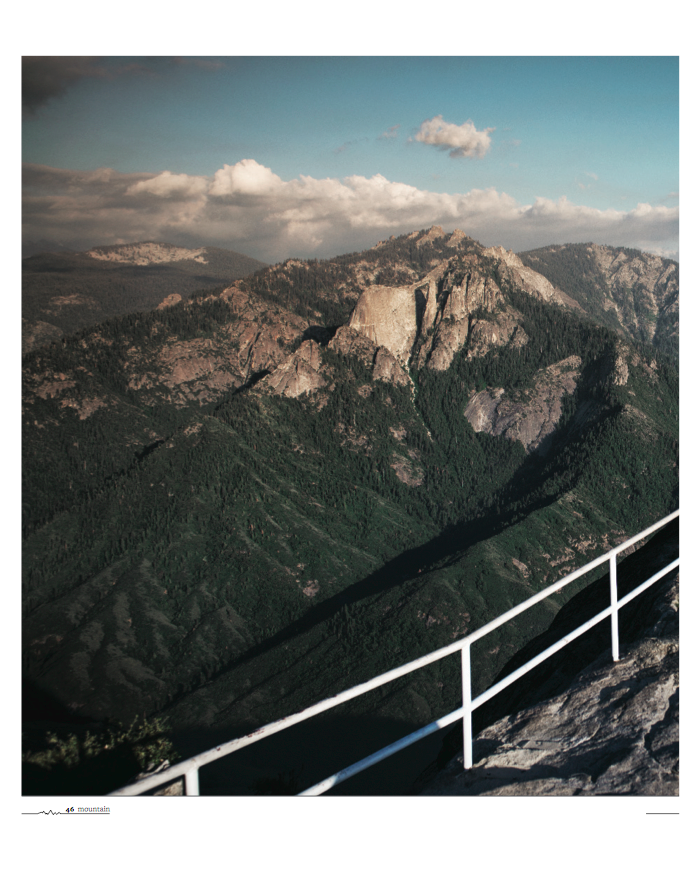
At about 6 p.m. on Sunday, November 20, 2005, Inman got a call from the ranger in charge of a team responding to a fatality on Moro Rock. Just before 4 p.m. hikers heard howls of grief from a young man who said that his companion had just jumped to his death. The ranger in charge said the situation was highly suspicious. She tapped Inman to assist in the investigation, which really meant take it over.
Inman took the call at home in a little duplex cabin in a park employees’ residential area. The man who went off the rock was Santos Teixeira, a 54-year-old pastor in Porterville, a depressed town down in the Central Valley. Teixeira faced multiple charges for rape and sexual assault of two teenaged sisters in his congregation. He was to stand trial in less than a month.
Nobody saw Teixeira go over the walkway railing except the 25-year-old man with him. That same man happened to be the older brother of the teenage girls who had accused Teixeira. For the purposes of this article, the young man will be called Luis Espinoza, a plausible name for the illegal immigrant from Mexico that he is. He gets the pseudonym so as not to give away the family name shared with his sisters—who as alleged sex crime victims can’t be identified.
No, it didn’t sound like suicide to Inman, either, and for that, professionally, he felt fortunate. In late November, high paperwork season for government employees, on a day off no less, he had just received his first possible homicide as lead case agent. “I was highly motivated,” Inman says.
Cell phone coverage was spotty in the park, so he stayed in the cabin and gave phone instructions to secure the scene at Moro Rock, where a search-and-rescue team was hunting for the body. He told the rangers to isolate Espinoza with park people. Then he drove the 16 miles to the Giant Forest Museum near Moro Rock, where Espinoza was being held.
While Inman drove, Espinoza told rangers about himself, his pastor, his sisters and their allegations, and a strange, nervous day that began at morning service at Teixeira’s Iglesia del Nazareno, a Hispanic satellite of Porterville’s main Church of the Nazarene.
At the museum, Inman listened as his colleagues gave their accounts. To one and all, Espinoza had expressed his love and deep belief in Pastor Santos Teixeira. He said Teixeira was like a father to him. He did not understand how such a man could kill himself. He didn’t want to believe his sisters’ accusations against Teixeira, but even if they were true he would remain loyal to his pastor.
Nothing he heard changed Inman’s view. “From the beginning, I thought this was likely murder,” he says. At 7:20 P.M., Inman went into a small office and began questioning Espinoza.
Inman presented himself as calm, even sympathetic. By that time Espinoza was cried out and calm, too. He struck Inman as mousy and naïve, but physically capable of throwing a man from a cliff. Inman inspected Espinoza’s hands and arms for scratches or other signs of violence. Nothing. He asked if Espinoza was angry at Teixeira. Espinoza said anger was not God’s way. Inman responded that even God might get mad if somebody in a position of trust preyed on innocents. But Espinoza did not show anger, which could open a door to a confession.
Regardless, Inman says he accomplished his primary goal in an initial interview: “You lock a person into a story immediately.” Then, as the suspect retells the story, you listen for inconsistencies indicative of lying. On that first night, Inman says, Espinoza told four people similar stories.
A look at his cell phone confirmed Espinoza’s claim that he had in fact called 911 twice immediately after his pastor died. But there was no signal. Remarks reportedly made by a Mexican man who had passed Teixeira and Espinoza on Moro Rock confirmed that—as Espinoza had insisted—the pastor acted crazed right before his death.
Two of Espinoza’s claims, however, just seemed off. Before he died, Teixeira handed his car keys to Espinoza, telling the younger man that he’d be driving home. And later he took off his suit jacket and set it down carefully. This could point to prior knowledge of death, and therefore suicide. Nevertheless, Inman considered the case a probable murder.
Inman told Espinoza he was a suspect, but that he would be free to leave after the interview. Minus a third-party eyewitness or damning physical evidence—not likely on barren granite at night and as yet with no body—it was too soon to read Espinoza his rights. “If I arrest this guy on suspicion of murder,” says Inman, “it starts the prosecutorial clock.” As it was, a U.S. attorney would have a hard time making charges stick, and Inman was pretty sure Espinoza would stay findable.
As Inman told Espinoza he could go home with his older sister, who had come to the museum, Teixeira’s shocked and grieving wife and son, and a cadre of wrought-up church folk gathered down at park headquarters. They proclaimed Espinoza’s obvious guilt, said that he’d run if released, and that Pastor Santos Teixeira would not commit suicide.
Inman called Porterville police, who were already aware of the death, and said he just released a suspect who some were convinced had murdered Teixeira. There might be trouble. Inman also contacted the Fresno field office of the FBI, which would open its own case. Like other big parks—Yosemite, Yellowstone—Sequoia law enforcement is feds only.
At roughly 9 p.m., in the glare of a portable spotlight, a ranger on the park’s technical search and rescue team named John Anderson rappelled down Moro Rock on a rope fixed to the same railing Teixeira went over. “That wouldn’t be a place where I would want to jump off to kill myself,” says Anderson, now a ranger at Kenai Fjords National Park in Alaska. The uneven rock face at that point gave a body a lot to hit on the way down, as blood smears found in daylight would show. About 400 vertical feet down, Anderson found Teixeira’s body on a ledge. “His shoes had come off,” says Anderson, who volunteered to stay the night on the ledge, next to the badly broken body, to protect evidence. “It doesn’t gross you out, after you’ve seen a lot of this sort of thing. I had on a down jacket and some extra clothes. At one point before dawn I made a little fire to warm myself.…Sitting with my back against the rock, watching the sun come up from the east, felt really nice.”
The death scene and autopsy did nothing to build a murder case. If there was forensic evidence on the body, it was lost as the granite monolith brutally beat Teixeira to death. The FBI polygraph technician and questioner, whose work Inman admired, ended up undecided. He said he never before had a subject break down emotionally as Espinoza had without confessing or at least divulging something new. Espinoza went right on telling his consistent story.
And Inman and his team began to delve into the life, or lives, of Pastor Santos Teixeira.
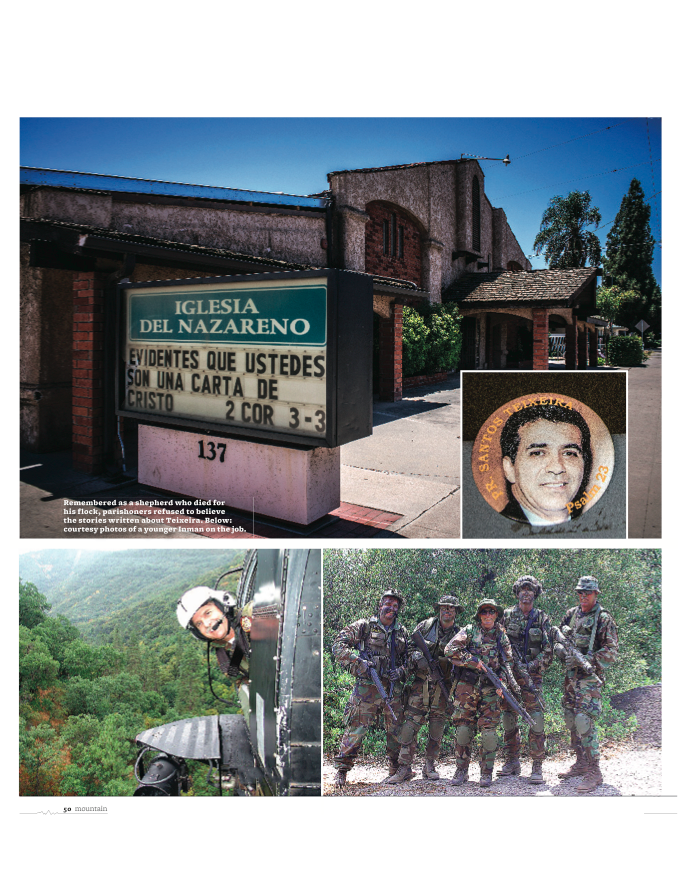
Inman’s career as a Park Ranger began as a calling. He grew up mostly abroad, as his father took diplomatic posts in the Philippines, Venezuela, Korea, Japan, and Mexico City—where Inman graduated from high school. To provide the family with a home on native soil, Inman’s parents bought property in the foothills of the Sierra Nevada near Yosemite National Park. “Home leave was every three years, and we’d go for three or four months,” says Inman, “That was our America. Yosemite.”
When he was 10 years old, Inman saw horseback mounted rangers in the Yosemite Valley and discovered his life path: “I just wanted to be that guy. That’s all. In that place.” Early in his NPS ranger career he was exactly that guy, on horseback in Yosemite Valley, which another Park Service retiree named Dan Dellinges tells me would have been perfect Inman. Dellinges and Inman worked together during an eventful decade at Death Valley National Park, where Dellinges seems proud to have been both a loose cannon and king-hell law enforcement ranger. “Imagine Eric as a law enforcement ranger on a horse in Yosemite,” he says. “He was the iconic looking ranger.”
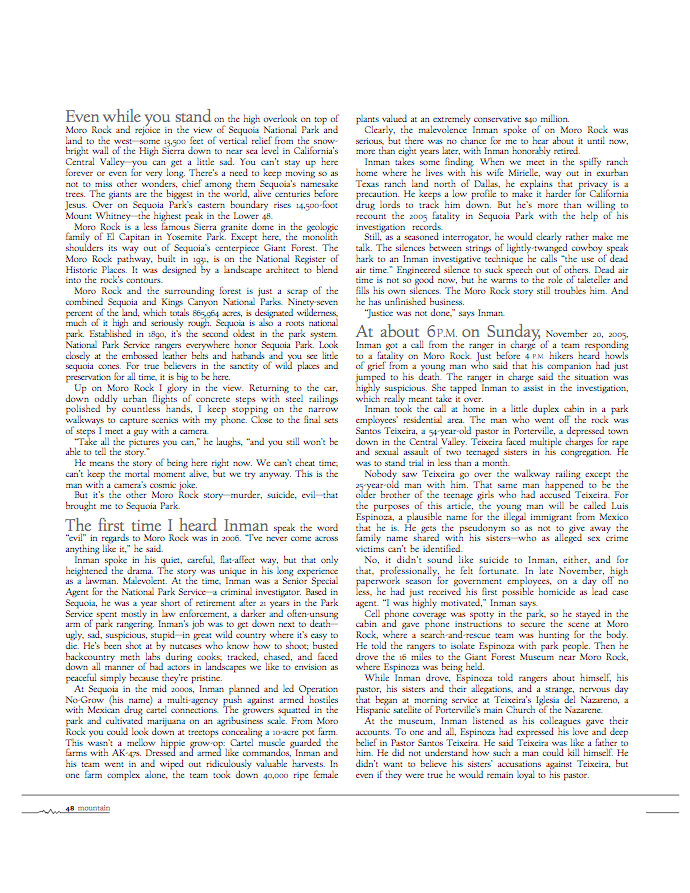 Remembering his time as a mounted backcountry ranger patrolling Yosemite’s high, little-visited Northwest section makes Inman wistful: “Pack up, load all your supplies on your mule, and head out alone. That was the best job I ever had in my life.”
Remembering his time as a mounted backcountry ranger patrolling Yosemite’s high, little-visited Northwest section makes Inman wistful: “Pack up, load all your supplies on your mule, and head out alone. That was the best job I ever had in my life.”
By 1990, Inman was a law enforcement ranger in Death Valley, where he patrolled almost a half million acres of baked nowhere in a 4×4. Five years later, Inman became Death Valley’s first criminal investigator. Dellinges lists the regulars who prowled the desert: “White supremacists, satanic cultists, survivalists, and just general, I don’t know what you’d call them—heavily armed groups whose motivations were unknown.”
At Death Valley, Inman led an NPS fire team in a multi-agency shootout with three anti-government crazies that involved full-on desert warfare tactics. The government inserted personnel via military Blackhawk helicopters. Gunfire brought down a police helicopter (no casualties). Dellinges, involved in this and other enforcement adventures with Inman, says Inman was a “heat seeker. He never backed off. In any kind of situation I knew I could count on him.”
From when he first became an investigator, Inman worked his cases the way he worked the death of Santos Teixeira—going harder, farther, longer than he needed to—and then he wrote reports the way he investigated, so somebody, some day, could go deeper.
In the summer of 1996, four German tourists, two adults and two kids, disappeared when their rented minivan got stuck in the Death Valley hell-and-gone. The prevailing theory was that they walked off and died. Nothing of them turned up until 2009 when Tom Mahood, a famed freelance desert tracker, found the bones. He never met Inman, but he says that, “without his rather amazing report, this probably would have still been a mystery.”
For his part, Inman sees no irony in the fact that he’s spent his career involved in misery in the most tranquil landscapes on earth. “Where you have victims,” he says, “you have victimizers.”

The more Inman dug, the more he realized he had another likely killer—Santos Teixeira himself, who had motives for suicide as powerful as Espinoza’s motives for murder. After his arrest in July, Teixeira spent 12 weeks in jail before a judge granted bail. (Incredibly, Espinoza wrote a letter of support that he said helped to get Teixeira released.) In the trial, set to begin in less than three weeks, guilty verdicts on the rape charges alone could put Teixeira away for 45 years—effectively life in prison for a 54-year-old. More damning, the younger of his two accusers, then 17, had testified under oath at a pretrial hearing that Teixeira threatened suicide if she told anyone he’d raped her.

The rape case led Inman back to earlier police cases involving Teixeira. Shortly thereafter he made contact with senior clergy of the Church of Nazarene. They too held profound doubts about Teixeira. The picture Inman paints is of a man with a secret self, going wrong while frantically trying to remain a blameless Man of God in the eyes of those who deeply believed in him, which by all accounts was easy to do.
“There were things that I saw that made me fall in love with him, want to follow him,” says Francisco “Frankie” Olmedo, Teixeira’s assistant pastor who now heads the Iglesia del Nazareno. Years later, Olmedo shines with affection for his spiritual leader and friend as he converses in Teixeira’s old office next to the stucco Iglesia. The church sits at the edge of downtown Porterville (population 55,000), a scratchy meld of old farm town and East L.A. barrio in one of California’s poorest rural counties.
Olmedo’s story of Teixeira’s arrival in Porterville in 1997 rings fated. As if an invisible hand moved events. Teixeira first came to Porterville to translate for his older brother Amadeu, a high-profile Nazarene minister in Brazil brought to the U.S. to speak. At the time, Santos was a social worker in Grand Rapids, Michigan, where he had gone to college and lived with his wife of 22 years, Maribeth, and their two children. Pastor John Denney of Porterville’s main Nazarene church took the Teixeira brothers on a sightseeing trip to Sequoia National Park, where he asked Santos to come to Porterville. “They went to the very spot where he died,” says Olmedo.
Teixeira, a natural-born church pastor gifted with charm, boundless energy, leadership, and, as Olmedo says, “Brazilian flair,” immediately vitalized his Iglesia. “The congregation fell in love with him,” says Olmedo. “You saw somebody taking action.” From 25 members, Teixeira built a church that at its peak would pack in crowds of more than 300 worshippers. Along the way he established new Iglesias in other Central Valley towns.
“He did a lot of good for people,” says Maribeth in a long phone talk. Then she cries because doing good meant leaving Michigan. “That’s where I was born and raised.…I wouldn’t have (left) if I had known the hell I would go through.”
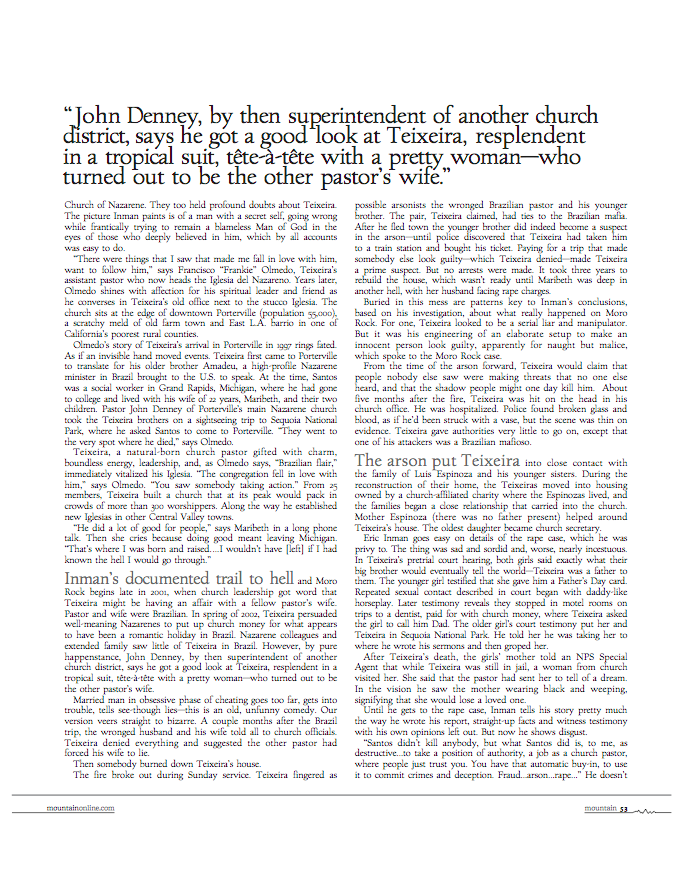
Inman’s documented trail to hell and Moro Rock begins late in 2001, when church leadership got word that Teixeira might be having an affair with a fellow pastor’s wife. Pastor and wife were Brazilian. In spring of 2002, Teixeira persuaded well-meaning Nazarenes to put up church money for what appears to have been a romantic holiday in Brazil. Nazarene colleagues and extended family saw little of Teixeira in Brazil. However, by pure happenstance, John Denney, by then superintendent of another church district, says he got a good look at Teixeira, resplendent in a tropical suit, tête-à-tête with a pretty woman—who turned out to be the other pastor’s wife.
Married man in obsessive phase of cheating goes too far, gets into trouble, tells see-though lies—this is an old, unfunny comedy. Our version veers straight to bizarre. A couple months after the Brazil trip, the wronged husband and his wife told all to church officials. Teixeira denied everything and suggested the other pastor had forced his wife to lie.
Then somebody burned down Teixeira’s house.
The fire broke out during Sunday service. Teixeira fingered as possible arsonists the wronged Brazilian pastor and his younger brother. The pair, Teixeira claimed, had ties to the Brazilian mafia. After he fled town the younger brother did indeed become a suspect in the arson—until police discovered that Teixeira had taken him to a train station and bought his ticket. Paying for a trip that made somebody else look guilty—which Teixeira denied—made Teixeira a prime suspect. But no arrests were made. It took three years to rebuild the house, which wasn’t ready until Maribeth was deep in another hell, with her husband facing rape charges.
Buried in this mess are patterns key to Inman’s conclusions, based on his investigation, about what really happened on Moro Rock. For one, Teixeira looked to be a serial liar and manipulator. But it was his engineering of an elaborate setup to make an innocent person look guilty, apparently for naught but malice, which spoke to the Moro Rock case.
From the time of the arson forward, Teixeira would claim that people nobody else saw were making threats that no one else heard, and that the shadow people might one day kill him. About five months after the fire, Teixeira was hit on the head in his church office. He was hospitalized. Police found broken glass and blood, as if he’d been struck with a vase, but the scene was thin on evidence. Teixeira gave authorities very little to go on, except that one of his attackers was a Brazilian mafioso.

The arson put Teixeira into close contact with the family of Luis Espinoza and his younger sisters. During the reconstruction of their home, the Teixeiras moved into housing owned by a church-affiliated charity where the Espinozas lived, and the families began a close relationship that carried into the church. Mother Espinoza (there was no father present) helped around Teixeira’s house. The oldest daughter became church secretary.
Eric Inman goes easy on details of the rape case, which he was privy to. The thing was sad and sordid and, worse, nearly incestuous. In Teixeira’s pretrial court hearing, both girls said exactly what their big brother would eventually tell the world—Teixeira was a father to them. The younger girl testified that she gave him a Father’s Day card. Repeated sexual contact described in court began with daddy-like horseplay. Later testimony reveals they stopped in motel rooms on trips to a dentist, paid for with church money, where Teixeira asked the girl to call him Dad. The older girl’s court testimony put her and Teixeira in Sequoia National Park. He told her he was taking her to where he wrote his sermons and then groped her.
After Teixeira’s death, the girls’ mother told an NPS Special Agent that while Teixeira was still in jail, a woman from church visited her. She said that the pastor had sent her to tell of a dream. In the vision he saw the mother wearing black and weeping, signifying that she would lose a loved one.
Until he gets to the rape case, Inman tells his story pretty much the way he wrote his report, straight-up facts and witness testimony with his own opinions left out. But now he shows disgust.
“Santos didn’t kill anybody, but what Santos did is, to me, as destructive…to take a position of authority, a job as a church pastor, where people just trust you. You have that automatic buy-in, to use it to commit crimes and deception. Fraud…arson…rape…” He doesn’t finish the thought; give the thing a name.
Inman is a devout, born-again Christian, and the idea that religious authority was used as leverage to do harm deepens his outrage. But the violation of trust is reason enough. In his report, Inman tried to serve a sort of posthumous justice. The written legacy makes connections no one else would have made. People can know, based on his investigation, what type of man died on Moro Rock.
Now we’re talking about Evil. “The pot guys weren’t Evil—they were in business. Bad is behavior. Evil is anti-God.” Inman’s kind of Evil is a living presence on this Earth, fighting our better selves from without and within. But you can take out God and Satan and still get what Inman means. There are deeds that destroy people and don’t gain those who perform the acts anything worth having. That’s what Inman believes consumed Santos Teixeira in his last moments alive on Moro Rock: A calculated act to make the young man who loved him a murderer—and Teixeira a martyr.
In the days before Moro Rock, Teixeira spoke of threats that no one else heard. A sense of imminent danger circled about him. Witness reports said Teixeira wondered out loud if Luis was against him. He said that Luis wanted to have things out. The last time his wife heard Teixeira’s voice, in a short, cryptic cell phone call he took on the way to Moro Rock—the only call he picked up among dozens he ignored—he said one last time, “My life is in danger.”
And then Teixeira’s blood stained Moro Rock.
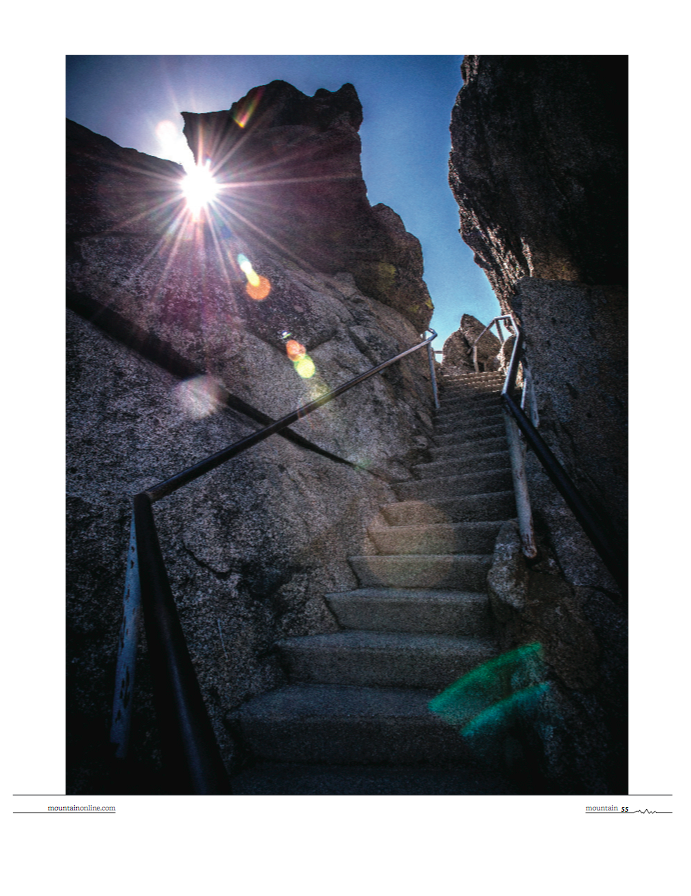
There’s nothing new here from Luis Espinoza. The young man could not be found. All we have is the Moro Rock narrative he told. Inman believes the story, but as an investigator he has a caveat: “Espinoza could have gotten away with murder. But if I was asked on the stand, ‘Do you have an opinion?’ then I would answer, in my opinion as unbiased fact-finder, that this was a setup.”
As Inman tells the story, Espinoza seems more boyish than the man in his mid-20s he was. Teixeira is both father figure and pastor to the mousy and naïve younger man. His power is both paternal and Godly. It’s power enough for Espinoza to show his back to his own family.
The pastor wants Espinoza to come to church this Sunday for sure, in order to meet with somebody on the defense team who will be there with documents to be signed by friendly witnesses. At church, Teixeira tells Espinoza that after the service they have to pick up a car he’s acquired for him. He tells Espinoza to sit up front during the service.
Some people will infer a “goodbye” in that final service; in the hymn Teixeira chooses to sing; and the words of thanks he offers to the congregation for their support. As he sermonizes Teixeira pins Espinoza with his eyes.
After service, Teixeira tells Espinoza to hurry. People in the congregation see them drive off together—Teixeira at the wheel. Some are worried. The person from the lawyer’s office is there. Pastor Santos should not be alone with Luis.
They stop at a gas station and buy cold sodas. Teixeira drives in the opposite direction of the car they’re supposed to pick up. Still, the pastor talks about the car and other good deeds he will do for Espinoza. He’s going to fix things with the disapproving parents of the girl Espinoza wants to marry. He will find a home for the newlyweds.
But Teixeira also talks about the damage done to him by the Espinoza family. He likens himself to a rose with the petals pulled off. They can’t be put back. By the time they get to the Sequoia Park entrance, Espinoza is scared. His mother told him to stay away from the pastor. He tries to catch the eye of the rangers at the gate so they remember him. They don’t. Espinoza has only been to Sequoia Park once, and never to Moro Rock.
On the rock, Teixeira speaks of Job, a righteous man punished by God just to test how righteous he was. At the overlook, he hands Espinoza his keys. On the way back down, Espinoza walking in front, Teixeira praises God and sings. He throws an empty soda bottle over the edge, saying that he wants to hear how it sounds. Then he stops, sets down his jacket, and tells Espinoza to look at the deer down below. Espinoza starts to come close, but Teixeira says, “No, you can see them from where you are.”
He speaks his last words: “Goodbye, Luis.”
Sightseers and climbers scaling Moro Rock hear the boy howling.
From the Summer 2014 issue. Golden Globe and Emmy nominated producer Steve Lee Jones and his award-winning Bee Holder Productions banner have secured life and film rights to tell this incredible story on the silver screen. Mountain contributor Mike Steere wrote “Punching Canadian Rocks” for the Winter 2014 issue.


